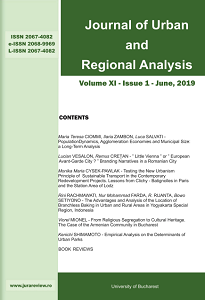POPULATION DYNAMICS, AGGLOMERATION ECONOMIES AND MUNICIPAL SIZE: A LONG-TERM ANALYSIS
POPULATION DYNAMICS, AGGLOMERATION ECONOMIES AND MUNICIPAL SIZE: A LONG-TERM ANALYSIS
Author(s): Maria Teresa Ciommi, Ilaria Zambon, Luca SalvatiSubject(s): Public Administration, Political economy, Rural and urban sociology, Economic development, Socio-Economic Research
Published by: Editura Universitară
Keywords: administrative domain; local development; urban growth; population density; Europe;
Summary/Abstract: Under the hypothesis that modifications in municipal boundaries and creation (or suppression) of new administrative units reflect a progressive adjustment toward a more balanced distribution of population over space, the present study investigates the long-term relationship (1928-2012) between urban expansion, population dynamics and municipal area in a growing metropolitan region (Athens, Greece). In expanding regions, municipal size is a key variable outlining the amount and spatial concentration of services and infrastructures, resulting to be functionally related to population density, agglomeration factors, land availability to building and characteristic socioeconomic profiles of local communities. A statistical analysis of the relationship between population density and municipal area provides basic knowledge to policy and planning adjustments toward a more balanced spatial distribution of population and land among the local government units. Descriptive statistics, mapping, correlation analysis and linear regressions were used to assess the evolution of such relationship over a sufficiently long time period. The average municipal area in Athens decreased moderately over time, with a slight increase in spatial heterogeneity. Conversely, the average population density per municipality increased more rapidly, with a considerable reduction in spatial heterogeneity. The observed goodness-of-fit of the linear relationship between population density and municipal area increased significantly over time. The empirical results of our study indicate that municipal size has progressively adjusted to population density across metropolitan areas, determining a more balanced spatial distribution of the resident population, which was consolidated by the recent administrative reform of the local authorities in Greece (the so called ‘Kallikratis’ law). Such conditions represent a base for the informed analysis of the spatial structure of local administrative units and they contribute to the debate on the optimal size of municipalities and other administrative districts with relevant impact on both urban and metropolitan scales of governance.
Journal: Journal of Urban and Regional Analysis
- Issue Year: 11/2019
- Issue No: 1
- Page Range: 5-17
- Page Count: 13
- Language: English

